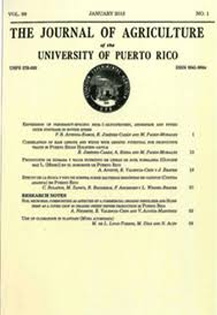Abstract
Coffee, Coffea arabica L., is planted in diverse agro-ecological environments in the mountains of Puerto Rico (PR). The pathogen, Xylella fastidiosa Wells et al., is a xylem-limited phytopathogenic bacterium transmitted by insects that causes coffee leaf scorch, citrus-variegated chlorosis and vascular diseases of many other plant species. The objective of this study was to characterize the fastidious endophytes occupying a similar niche as X. fastidiosa in the vascular system of Citrus sinensis and Inga vera trees in low diversity and high diversity shade environments where coffee is grown In PR. Sampling was conducted over two years in four localities: Adjuntas, Jayuya, Las Marías and Yauco during the dry and rainy seasons. Citrus sinensis and Inga vera were generally the only shade treesin coffee plantations described as "low diversity"; in "high diversity" plantations these same species were present along with Pithocellobium carbonarium, Gliricidia sepium and Andira inermis. Endophyte population (EP) and endophyte diversity (ED) were contrasted using factorial arrangements of shade, locality, season and year. Endophytes were clustered using multivariate analysis. Neither shade nor season had an effect on EP in Citrus. In Inga vera, EP was about three times higher in the second year compared to the first year regardless of season, location or shade. In both Citrus and Inga, ED was low. The highest ED was detected in Jayuya and the lowest in Las Marías. Ward's algorithm combined Citrus and Inga fastidious strains into four and five clusters for Gram-negative and Gram-positive bacteria, respectively. Endophyte diversity of Citrus and Inga was determined by the plant species, not by location or shade. However, ED was higher in shaded coffee with low diversity of tree species. Thus, effects of shade (low versus high diversity) altered the community structure of endophytes prevalent in the vascular tissue and may impact host plant resistance to pathogens such as X. fastidiosa.

